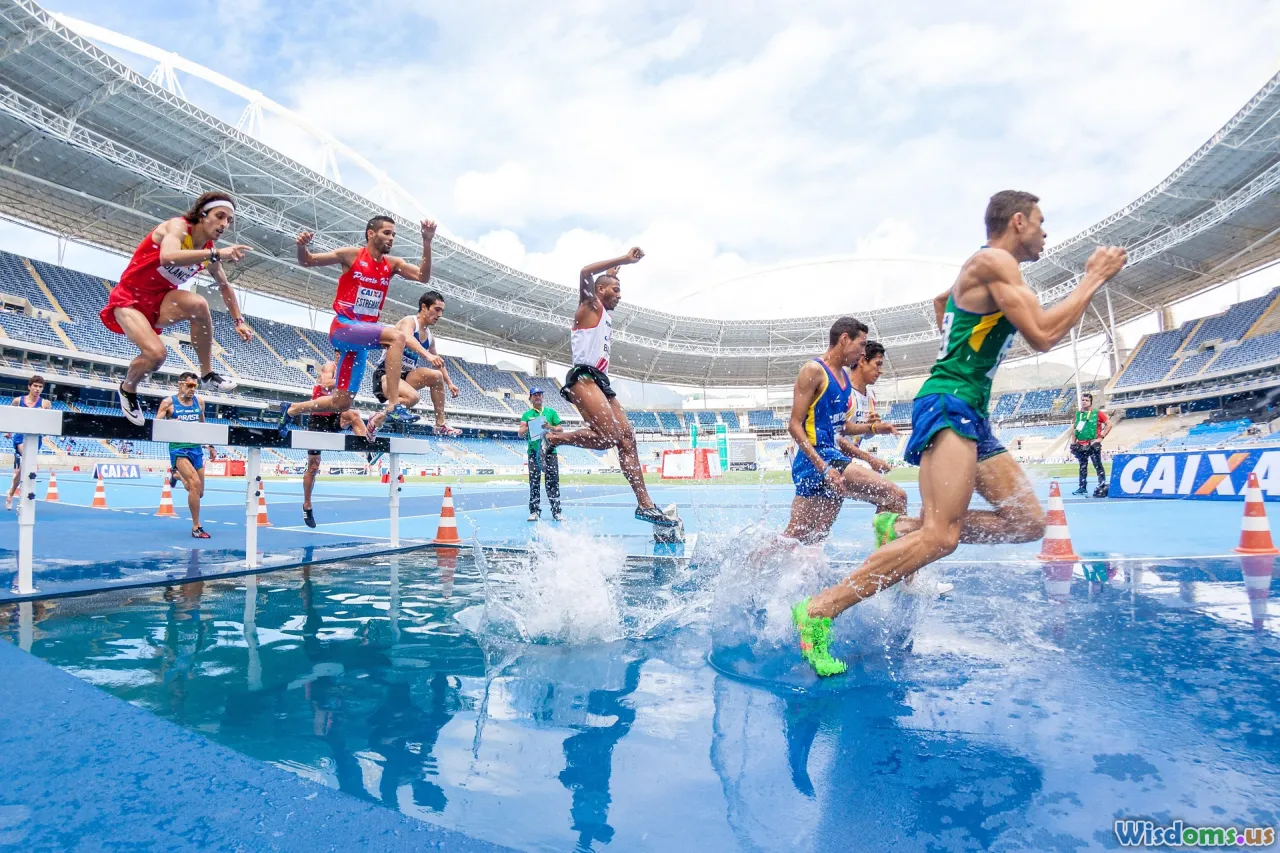
Secrets Behind Olympic Athletes Winning Morning Routines
33 min read Discover how Olympic athletes design winning mornings—light, hydration, mobility primers, fueling, and mindset—to boost performance and recovery, with science-backed tips you can adapt before 9 a.m. (0 Reviews)
The alarm hasn’t rung yet, and somewhere a swimmer is already cutting a silent line through a dark pool, a marathoner is lacing shoes in pre-dawn stillness, and a gymnast is rolling out a mat for the day’s first set of drills. The world calls them “morning people,” but the truth is more deliberate: Olympic athletes build mornings that win. Their routines are engineered for reliability under pressure, primed for neurochemistry and movement quality, and modular enough to travel from Tokyo to Paris to Los Angeles without unraveling.
This guide unpacks the principle-driven, evidence-informed morning routines that help Olympians hit peak consistency. You’ll get concrete examples, pro-level checklists, and practical adaptations for real life—no altitude tent required.
Why Mornings Matter to Performance

A morning routine isn’t about being virtuous or performing wellness theater—it’s a consistent protocol to reduce decision fatigue and control controllables. Here’s why mornings are mission-critical for athletes.
- Circadian leverage: Body temperature, hormone levels, and reaction speed follow daily rhythms. The cortisol awakening response (CAR) peaks shortly after waking, boosting alertness and helping mobilize energy if paired with light movement and light exposure. Athletes harness this natural rise instead of fighting it.
- Event timing realities: Many Olympic sports hold qualifiers or heats in the morning. During the Tokyo Games, some swimming finals were moved to morning local time to accommodate global broadcast schedules. Morning readiness is not optional; it’s competitive necessity.
- Decision energy: A stable routine protects scarce mental bandwidth for competition and training. The fewer choices early on, the more focus remains for the hard work later.
- Injury risk mitigation: Stiffness after sleep elevates injury risk if you jump straight into maximal efforts. A disciplined sequence (hydration, activation, mobility) lowers the odds of pulling something at 7:15 a.m.
Winning mornings are less about hacks and more about sequencing: wake, light, fluids, breath, movement, fuel, and readiness check. The rest is personalization and sports-specific tuning.
Design the Wake-Up That Sets the Tone

Elite routines start before feet hit the floor. The first 15 minutes set circadian timing, energy availability, and mental tone.
- Consistent wake time: Olympians treat wake-up like a practice: same window daily, including travel days. Consistency anchors circadian rhythms better than sporadically “sleeping in.”
- Light on purpose: Aim for 5–15 minutes of outdoor light exposure soon after waking when possible. Morning light helps align your body clock and reduces grogginess. On dark mornings, use a bright lamp or dawn simulator (position it at eye level, not overhead, to minimize glare). Even high-lux indoor lamps won’t replicate sunlight perfectly, but they’re better than dim rooms.
- Gentle activation: A 1–2 minute movement pulse (cat-cow, ankle circles, shoulder rolls) turns on proprioception and joint lubrication. Think: oil the bearings before rolling at speed.
- Wake-up breath: Two to three rounds of the “physiological sigh” (two short inhales, one long exhale) reduce sleep inertia and anxiety. It’s fast, portable, and works before major meetings as well as workouts.
- Early digital discipline: Avoid diving into social feeds or email during the first 30 minutes. Reactive inputs hijack attention and raise stress before you’ve even fueled.
If you struggle to wake up, place your alarm across the room and stand in light as soon as possible. A warm shower can reduce sleep inertia; save the cold blast for later in the routine if you use it at all.
Hydration and Electrolytes: The Quiet Performance Edge

Overnight, you lose fluid through breathing and sweat—even more at altitude or in dry rooms. Mild dehydration (as little as ~1% body mass) can increase perceived exertion and reduce power output.
- Morning check-in: If you track weight, compare to your usual baseline. A 0.3–1.0% drop likely means fluid deficit. If you don’t track, use a urine color chart (aim for pale straw) and mouthfeel (sticky or dry suggests topping up).
- Practical rehydration: 500–750 ml of fluid within the first hour usually resets most people, especially if you add 300–600 mg sodium. Plain water is fine for light training; add electrolytes for longer or sweat-heavy sessions.
- Easy options: Salt a glass of water and add lemon, use an electrolyte tab, or mix a pinch of salt and a teaspoon of honey in warm water if you prefer a milder start.
- Avoid over-drinking: Chugging liters right away can dilute sodium. Spread fluid through the hour and aim for balance.
If you’re a heavy sweater or cramp-prone, consider a pre-session sodium plan. Endurance athletes often benefit from ~500–1,000 mg sodium per hour in hot conditions; testing in training is essential.
Mental Priming: Calm Body, Competitive Mind

Olympic mornings protect a few quiet minutes for the mental game. Many athletes use visualization, breath work, or cue words to build a controlled, competitive state.
- Visualization blueprint: Swimmers like Michael Phelps have famously rehearsed races in their head—starts, turns, breathing patterns, and the feeling of the final 15 meters. Do 3–5 minutes of mental reps: see your technique, hear the sounds of your environment, feel the effort.
- Breath protocols: Try one of these in the first 10 minutes:
- Box breathing 4-4-4-4 (inhale-hold-exhale-hold) for composure and focus.
- 4–7–8 (inhale 4, hold 7, exhale 8) to reduce tension.
- Physiological sighs (2 quick inhales, long exhale) to rapidly dampen stress.
- Cue words: Short phrases like “tall and quick” (running form) or “heavy and fast” (weightlifting pull) anchor attention to controllable actions. Write one cue on a sticky note for the day’s main session.
- Micro-journaling: On one index card, list: 1) Today’s process goal (e.g., “Knees out on every squat”), 2) A 1% improvement target (e.g., “Smoother hand entry on stroke”), 3) One win from yesterday to build momentum.
The goal is not to feel hyped; it’s to feel organized. The best competitors report a sense of calm readiness, not shaky adrenaline.
Mobility and Activation: RAMP Your System

The most reliable warm-ups follow a simple RAMP model: Raise, Activate, Mobilize, Potentiate. Each phase takes 2–5 minutes.
- Raise: Build body temperature and heart rate. Options: 2–4 minutes of brisk walking, jump rope, or stationary bike. Keep it conversational.
- Activate: Wake up prime movers. Mini-band lateral walks, glute bridges, scapular push-ups, and calf raises do more for performance than static hamstring stretches.
- Mobilize: Address key joints with dynamic moves: ankle rocks, hip openers, thoracic spine rotations, and leg swings. Aim at tight links in your kinetic chain.
- Potentiate: Add low-dose intensity to cue the nervous system. Examples:
- Sprinters: 2 x 20 m buildups + 2 x 10 pogo hops.
- Rowers: 2 x 10 explosive strokes with perfect timing.
- Weightlifters: 3 sets of 2 reps at 50–60% of working weight with crisp speed.
For desk-bound athletes, add a 60-second “posture reset” (chin tucks, wall slides) to counter rounded shoulders before pulling or overhead work.
Fueling for the Work: Carbs, Protein, and Timing

Morning fuel is a competitive choice. It needs to be digestible, repeatable, and matched to the day’s demands.
- Carbohydrate timing: For sessions under 60 minutes at easy/moderate intensity, a small snack may suffice. For hard or long training, target 1–2 g/kg of carbs within 1–2 hours pre-session to support power and concentration.
- Protein: 20–30 g protein in the morning supports muscle repair and satiety. If you train immediately on waking, consider protein post-session if pre-workout isn’t tolerated.
- Fat and fiber: Useful for sustained energy, but go lighter pre-high-intensity to reduce GI distress. Keep high-fiber foods for later meals when you’re not about to sprint or tumble.
- Simple athlete breakfasts:
- Endurance days: Oatmeal cooked in milk with banana, honey, and a sprinkle of salt; or rice porridge with soft egg and soy sauce. Sip electrolyte water.
- Strength/power days: Greek yogurt with berries and granola plus a slice of toast with peanut butter; or eggs on rice cakes with a small glass of orange juice.
- Skill/precision days: Keep it moderate—smoothie with milk, banana, spinach, oats, and whey; avoid super heavy meals that fog focus.
Practice your race-day breakfast during training. Your gut is trainable, and nothing sabotages a morning session like an unfamiliar fuel experiment.
Caffeine and Legal Ergogenics: When and How to Use

Used intelligently, caffeine and a few well-researched aids can sharpen morning performance. Misused, they cause jitters, crashes, or GI issues.
- Caffeine: For many, 1–3 mg/kg taken 30–60 minutes pre-session enhances reaction time and endurance. Start at the low end and test on normal training days. Some athletes delay caffeine 60–90 minutes after waking to avoid compounding early-morning grogginess and to align with natural alertness rise—experiment to find your best window.
- WADA status: Caffeine is permitted in sport but remains on monitoring lists. Know your federation’s guidance. Avoid excessive intake that impairs sleep.
- Beetroot juice/nitrates: Often used 2–3 hours pre-effort for endurance. Some athletes split doses across days. If you’re new to it, test on routine training runs first; some experience GI sensitivity.
- Sodium bicarbonate: Can buffer high-intensity efforts, but GI distress is common. If you explore it, consider smaller split doses and use only after careful practice with a nutrition professional.
- Creatine and beta-alanine: These are chronic supplements—morning timing is flexible. They don’t provide acute pop but build capacity over weeks.
Avoid stacking every possible supplement “just in case.” Olympians bias toward a few things that have proven, personal ROI.
Data-Driven Readiness Without Obsession

Wearables and simple measures help athletes calibrate morning training. The trick is to mix objective data with subjective feel.
- Simple metrics:
- Resting heart rate (RHR) and HRV: Morning trends, not single numbers, inform decisions. A sudden RHR jump with a low HRV may flag stress or insufficient recovery.
- Orthostatic test: Measure heart rate lying down and then standing for one minute. An unusually large jump can indicate fatigue or dehydration.
- Sleep and body temp: Note duration, estimated efficiency, and whether you woke hot or cold—useful after travel.
- Subjective check: Rate sleep quality, stress, muscle soreness, and mood on a 1–5 scale. Elite coaches take these “wellness scores” seriously.
- Adjustments:
- Green light: Normal numbers + good mood → proceed as planned.
- Yellow light: Mixed numbers or unusual soreness → extend warm-up, reduce volume by 10–20%, keep the quality.
- Red light: Clear physiological stress → swap for technical drills or aerobic maintenance and prioritize recovery.
Data serves you if it changes a decision. If it only alarms you, strip back to the basics and rebuild trust in your morning feel.
Thermal Techniques: Heat, Cold, and the Middle Path

Temperature shifts can speed wakefulness or reduce stiffness, but context matters.
- Warm-first approach: A warm shower or brief sauna exposure (if available) early in the morning reduces sleep inertia and helps tissue extensibility for mobility work.
- Cold with caution: A short cold rinse (30–90 seconds) after you’re already warm can sharpen alertness. Extended cold immersion before maximal strength or power sessions may temporarily dampen peak output—use brief exposure or save long cold baths for recovery sessions later.
- Contrast: Alternating warm and cool water can feel invigorating, but the most important variable is how you feel afterward. If you’re shivering during warm-up, you overshot.
Thermal tools are optional. If they complicate your schedule or mood, skip them and double down on light, breath, and movement.
Travel and Jet Lag: Keep Mornings Stable on the Road

Olympians spend seasons on the road. Their morning routines survive because they’re modular and guided by light exposure.
- Pre-shift strategy: For eastward travel, move bedtime and wake time earlier by 15–30 minutes per day for 3–5 days pre-flight. For westward, shift later. Small steps add up.
- Light timing: After landing, get daylight exposure aligned with your target local morning, and avoid bright light in the late local evening.
- Movement: Do a 10–15 minute mobility circuit after arrival to reduce stiffness and “tell” your brain you’re active in this new time zone.
- Melatonin: Low doses (often 0.5–3 mg) taken 2–3 hours before the new target bedtime can help with circadian shifting. Discuss with your physician or team doctor; regulations vary.
- Hotel hacks: Pack a travel kit—mini-band, electrolyte tabs, eye mask, and a compact light. Request a room with morning light exposure if available.
Rule-of-thumb adaptation rate is roughly one day per time zone crossed, but your routine accelerates this curve by controlling light, meals, and movement.
What Real Olympian Mornings Look Like (Composite Examples)

Every athlete is different, but patterns emerge across sports. The following composites are grounded in common, publicly shared habits of top competitors; use them to spark your own design.
-
The Swimmer’s Dawn Block (heat-ready):
- 4:50 a.m.: Wake, bright light on, 500 ml water with electrolytes.
- 4:55: 2 minutes of joint circles and 3 physiological sighs.
- 5:00: Small snack (banana + honey on half a bagel) and coffee if used.
- 5:15: Bus to pool; visualize starts and turns.
- 5:30: Deck activation (mini-band shoulders, ankle mobility, lunges).
- 5:40: Pool warm-up, building to short, crisp pace efforts.
- Notes: Swimmers practice morning racing even in training cycles to master the feel of speed early.
-
The Marathoner’s Rhythm (steady miles):
- 5:45 a.m.: Wake, step outside for 10 minutes of natural light.
- 5:55: Warm herbal tea or light coffee; 300–500 ml water with a pinch of salt.
- 6:00: Oats with a banana and a touch of honey.
- 6:30: Glute activation and calf raises; 10-minute easy jog.
- 6:45: Main run starts; gels carried for long runs.
- Notes: Many East African training groups start early to beat heat and wind; simplicity rules breakfast (bread, tea), and routines are consistent.
-
The Weightlifter’s Precision (power on demand):
- 7:00 a.m.: Wake, warm shower, 400 ml water with electrolytes.
- 7:10: 3 minutes of diaphragmatic breathing and joint prep.
- 7:20: Breakfast: Greek yogurt, berries, granola; or eggs and rice cakes.
- 8:15: Gym—RAMP warm-up, then barbell technique drills; potentiation sets before heavy pulls.
- Notes: Mental cues and consistent bar path practice dominate; caffeine is optional and lower-dose to avoid jitters.
-
The Gymnast’s Control (neuromuscular finesse):
- 6:30 a.m.: Wake, sunlight, 300 ml warm electrolyte water.
- 6:35: Mobility flow emphasizing wrists, shoulders, hips.
- 6:45: Visualization of routine sequences and landings.
- 7:00: Breakfast smoothie with milk, banana, oats, and protein.
- 7:45: Gym—technical drills, balance work, then power tumbling once fully activated.
- Notes: Gymnasts emphasize consistent arousal levels; too hyped hurts precision.
These are snapshots, not prescriptions, but they highlight the constant: light, hydration, breath, movement, and a breakfast matched to the session.
Build-Your-Own: Routines by Sport Demand
Use the following templates as starting points, then test and iterate.
-
Endurance template (runs, rows, rides):
- Light and hydration: 10 minutes outdoor light + 500–750 ml water with sodium.
- Fuel: 1–2 g/kg carbs if session >60 minutes or high intensity; small snack if easy.
- Warm-up: 5 minutes easy cardio + glute/calf activation + dynamic mobility.
- Potentiation: 2 x 20-second strides or spin-ups.
- Optional caffeine: 1–2 mg/kg 30–45 minutes pre-workout.
-
Strength/power template (weightlifting, throws, sprints):
- Warm shower then light exposure.
- Hydration: 400–600 ml fluid with electrolytes.
- Fuel: 20–30 g protein + moderate carbs; keep fats lower pre-lift.
- RAMP: Activation focused on hips, scapulae, and ankles; barbell technique drills.
- Potentiation: Jumps or light-speed sets before heavy work.
-
Skill/precision template (archery, shooting, gymnastics):
- Gentle movement + breath for calm alertness.
- Hydration: steady sips; avoid over-caffeination that shakes accuracy.
- Fuel: moderate carb + protein, minimal GI load.
- Drills: Gradually layer complexity; lock in cue words.
Adjust for your chronotype: If you’re a natural night owl, shift the whole routine later when training permits, or use brighter morning light and gradual sleep shifts to make early starts tolerable.
Common Pitfalls that Quietly Cost You Performance

- Inconsistent wake times: A “catch-up” weekend often wrecks Monday. Keep swing within 60–90 minutes.
- Coffee first, water never: Caffeine without fluids compounds dehydration. Hydrate first, then sip coffee.
- Static stretching before max power: Long static holds can reduce immediate force output. Use dynamic mobility and save long holds for post-session.
- New foods on key mornings: Your gut is conservative under stress. Practice any new breakfast at least 3–4 times in training first.
- Phone doomscrolling: Reactivity kills focus. Set app limits or put your phone on a charging station away from the bed.
- All-or-nothing thinking: One missed step isn’t failure. Hit the next step and move on.
A 30-Minute “If Life Happens” Routine

When schedules implode, use this condensed plan to keep your edge.
- Minute 0–3: Open blinds or step outside. Drink 300–400 ml water with a pinch of salt.
- Minute 3–5: Three physiological sighs + 60 seconds of joint circles.
- Minute 5–12: RAMP blitz—2 minutes brisk walk or jog in place; 2 minutes mini-band activation; 2 minutes dynamic hip/ankle mobility; 1 minute pogo hops or fast marching.
- Minute 12–15: Espresso or tea if you use caffeine; small snack (banana or toast with honey).
- Minute 15–28: Core session primer—3 rounds: 20 seconds quick feet, 20 seconds glute bridge, 20 seconds scap push-ups, 60 seconds easy.
- Minute 28–30: Review cue word for the day’s main effort, write one process goal.
You’ve covered light, hydration, breath, movement, and intent—enough to salvage a strong day.
Habit Architecture: Make It Stick When Motivation Fades

Olympians don’t rely on feeling inspired at 5 a.m. They build routine architecture.
- Implementation intentions: If-then plans reduce indecision. “If the alarm rings, then I sit up and turn on the lamp.” “If it’s raining, then I do my 10-minute mobility indoors before running.”
- Habit stacking: Attach new steps to existing anchors. “Hydration bottle goes next to the coffee maker.” “Mini-band lives by the bedroom door.”
- Environmental design: Lay out clothes and shoes overnight. Pre-pack breakfast components. Keep a travel kit ready.
- Constraints: Decide the night before which 3 steps are non-negotiable (e.g., light, hydration, activation). Everything else is optional.
- Feedback loop: Track adherence, not perfection. A simple checklist on the fridge beats a fancy app you don’t open.
Remember the goal: predictable mornings produce predictable training quality, which compounds into podium-level reliability.
Women-Specific Notes: Nuance That Matters

Morning routines are broadly similar across genders, but a few considerations help women tune precision:
- Iron status: Low iron or ferritin can blunt morning energy. Pair vitamin C with iron-containing foods at breakfast to aid absorption, and consult a clinician for testing and guidance.
- Cycle-aware hydration: Some athletes notice higher core temperatures and different fluid needs in the late luteal phase. Pay closer attention to electrolytes and cooling strategies on hot mornings.
- Fueling consistency: Fasted, high-intensity morning sessions can be more stressful for some women, especially when energy availability is low. A small carb-protein snack before or during early sessions can protect performance and recovery.
Individual responses vary widely; track patterns and adjust.
The Call Room and Race-Morning Logistics

Olympics mornings can include call rooms, equipment checks, and long waits. Champions make these lulls part of the plan.
- Backward planning: Start from the start time and work backward, adding buffers for transit, check-in, and warm-up. Write the schedule.
- Two-phase warm-up: Do a primary warm-up, then a maintenance loop if you’re held before competition (short mobility, breath, and 2–3 accelerations). Keep a light jacket to retain heat.
- Portable fuel and fluids: Carry familiar snacks and a measured bottle. Don’t rely on venue availability.
- Mental anchors: Headphones, a short mantra, or a breathing pattern help control arousal in noisy pre-start areas.
Rehearse the full timeline in a low-stakes event so the big day feels familiar.
A Week to Win the Morning: Progressive On-Ramp

Adopt your routine gradually over seven days to avoid overwhelm.
- Day 1–2: Fix wake time within a 30-minute band; add light exposure and 300–500 ml water.
- Day 3–4: Layer in a 7-minute RAMP warm-up; choose one breakfast you’ll repeat.
- Day 5: Add mental priming (breath + cue word + 2-minute visualization).
- Day 6: Test caffeine timing or nitrate strategy if relevant.
- Day 7: Do a full dress rehearsal for a key session from wake to cooldown, including travel logistics.
By the end of the week, you’ll have a routine that feels natural and travels well.
Troubleshooting: If It’s Not Working, Try This

- Still groggy after 30 minutes? Increase morning light and add 3–5 minutes of brisk movement before coffee. Consider a warm shower.
- Stomach upset on hard mornings? Shift more carbs to the night before, simplify breakfast, and push caffeine slightly later.
- HRV tanked, mood flat? Swap high-intensity for technique and breathing work, or nap later if schedule allows. Prioritize an early night.
- Can’t stick to the plan? Shrink it. Make a 3-step “minimum viable morning” and celebrate consistency over complexity.
The Minimalist’s Travel Kit

- Mini-band for activation
- Collapsible water bottle + electrolyte tabs
- Eye mask and earplugs for better sleep
- Small, high-lux travel light or bright desk lamp
- Index cards and a pen for cue words and checklists
This kit fits in a side pocket and keeps your mornings intact in unfamiliar spaces.
Your morning is the only part of the day that never has to sprint to catch up. Olympic athletes treat it like the quiet launch sequence that makes liftoff look effortless. You don’t need a gold medal to benefit from the same design: protect the first 30–60 minutes, sequence light–fluid–breath–movement–fuel, and build a routine that survives time zones and tough weeks. Do it long enough, and your mornings stop being something you “get through”—they become the reason everything else works better.
Productivity Success & Motivation Mindset Sports Science Health & Wellness Hydration Morning Routine Circadian Rhythm Success Habits & Routines Sleep Optimization Peak Performance Habits & Routines Olympic athletes performance habits mobility drills breathwork cold exposure nutrition timing HRV tracking
Rate the Post
User Reviews
Popular Posts

















